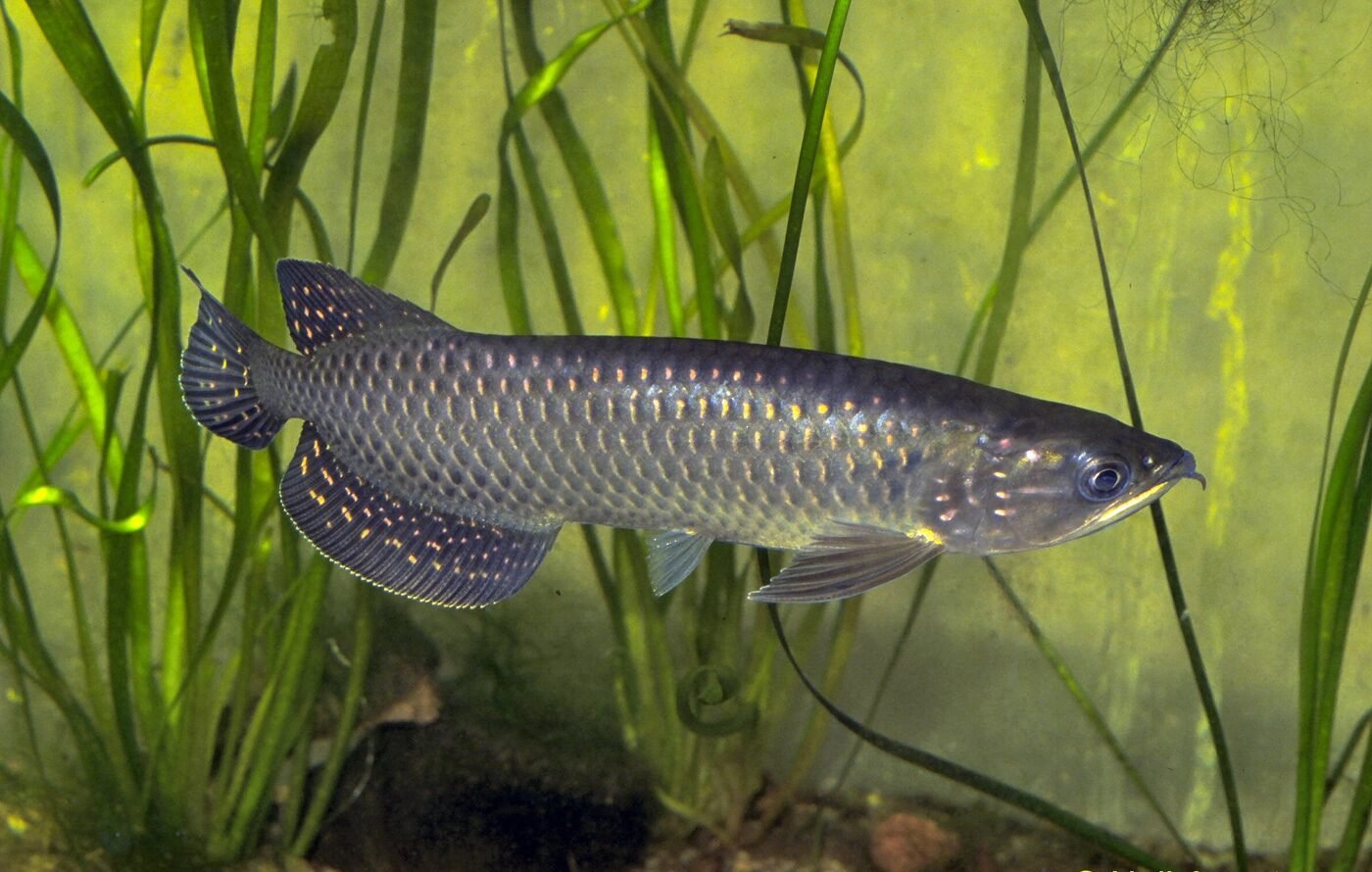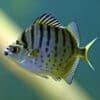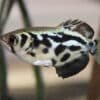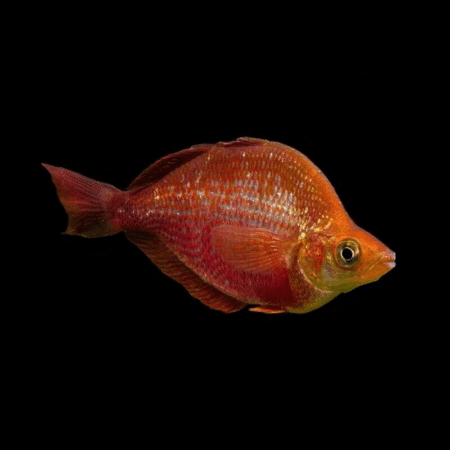Australian Bonytongue – Scleropages jardinii, Rare Tropical Fish Perfect for Enthusiasts Seeking Peaceful Companions and Low Maintenance Care in Their Brackish Aquariums
£588.49 Original price was: £588.49.£500.00Current price is: £500.00.
Welcome the Australian Bonytongue, a stunning addition to your aquarium. This exotic fish, known for its graceful movement and vibrant colors, thrives in brackish environments. Ideal for aquarists seeking peaceful companions, it enhances the beauty of any tank. Provide a loving home today!
Species Introduction
The Australian Bonytongue, scientifically known as Scleropages jardinii, is a captivating brackish fish native to the rivers and estuaries of Australia. This species is renowned for its striking appearance, characterized by elongated bodies, large scales, and a distinctive bony tongue that aids in feeding. As a member of the family Osteoglossidae, the Australian Bonytongue holds a special place among aquarists due to its unique aesthetic and fascinating behavior.
In its natural habitat, this fish thrives in warm, shallow waters, often found among submerged logs and dense aquatic vegetation. Its adaptability to varying salinity levels makes it an excellent candidate for brackish water aquariums, providing enthusiasts with an opportunity to recreate a slice of its natural environment. The Australian Bonytongue is not only a visual delight but also a testament to the diverse aquatic life found in Australia, making it a prized addition to any aquarium.
Key Features – Australian Bonytongue – Scleropages jardinii 14 cm
| Specification | Details |
|---|---|
| Benefits | Enhances your aquarium ecosystem |
| Quality | Premium aquarium-grade materials |
| Ease of Use | Simple setup and maintenance |
Care Requirements Dashboard
✓ Care Level: Moderate
Tank Size: Minimum 200 liters (53 gallons)
Water Temperature: 24-28°C (75-82°F)
pH Level: 6.5-7.5
Hardness: 5-15 dGH
Providing optimal care for the Australian Bonytongue requires a well-maintained aquarium that mimics its natural habitat. The tank should be spacious, as these fish can grow up to 14 cm (5.5 inches) in length. A minimum tank size of 200 liters is recommended to ensure they have ample swimming space. The water temperature should be kept between 24-28°C, with a pH level ranging from 6.5 to 7.5 to create a suitable environment for their health and wellbeing. Regular water changes and quality monitoring are essential to maintain the required hardness levels of 5-15 dGH. This species thrives in stable water conditions, so investing in a reliable filtration system is crucial for their long-term success.
Natural Behavior & Temperament
The Australian Bonytongue exhibits a variety of fascinating behaviors that make it a joy to observe. These fish are known for their inquisitive nature, often exploring their environment with curiosity. They are generally peaceful but can exhibit territorial behavior, particularly during breeding seasons or when they feel threatened. In a community aquarium, it’s essential to choose tank mates wisely to ensure harmonious interactions. They prefer to swim in the mid to upper levels of the tank, making it crucial to provide ample swimming space and vertical structure, such as driftwood and tall plants. This species is also known to be a good jumper, so a secure lid is necessary to prevent escapes. Their social behavior can be enhanced by keeping them in groups, but care should be taken to avoid overcrowding, which can lead to stress and aggression.
Tank Setup Guide
Setting up a suitable tank for your Australian Bonytongue involves careful consideration of various elements to recreate their natural habitat. Start with a spacious aquarium of at least 200 liters, as these fish require room to swim freely. The substrate should consist of fine gravel or sand, allowing for easy digging and foraging behavior. Incorporate plenty of hiding spots using driftwood, rocks, and live plants to create a comfortable environment that mimics their natural surroundings. Floating plants can provide shade and help diffuse lighting, which is beneficial for the fish’s wellbeing. Additionally, ensure that the tank has a reliable filtration system to maintain water quality and circulation. Regularly monitor water parameters to ensure they remain within the ideal ranges for the Australian Bonytongue, and perform routine maintenance to keep the tank clean and healthy.
Water Quality Management
Maintaining optimal water quality is crucial for the health and longevity of your Australian Bonytongue. Regular testing of water parameters, including pH, temperature, and hardness, is essential to ensure a stable environment. The ideal pH range for this species is between 6.5 and 7.5, with a temperature of 24-28°C. It’s important to use a high-quality water conditioner to remove harmful chemicals and toxins from tap water before introducing it to the aquarium. Regular water changes, approximately 20-30% weekly, will help maintain water quality and remove accumulated waste and toxins. Additionally, consider using a reliable filtration system that can handle the bioload of your aquarium, ensuring that ammonia and nitrite levels remain at zero. Monitoring nitrate levels is also important, as elevated levels can lead to stress and health issues in your fish. By maintaining these water quality parameters, you can create a thriving environment for your Australian Bonytongue.
Feeding & Nutrition
The Australian Bonytongue is an omnivorous species that thrives on a varied diet. In the wild, they primarily feed on small fish, crustaceans, and aquatic invertebrates. In captivity, it is essential to provide a balanced diet that includes high-quality pellets, frozen or live foods such as bloodworms, brine shrimp, and daphnia. A feeding schedule of 2-3 times per day is recommended, offering only what they can consume in a few minutes to prevent overfeeding and maintain water quality. As they are known to be surface feeders, floating pellets or flakes are ideal for ensuring they receive adequate nutrition. Additionally, incorporating vegetable matter, such as blanched spinach or zucchini, can provide essential nutrients and promote overall health. Monitoring their feeding habits and adjusting their diet based on their growth and health will help ensure your Australian Bonytongue remains vibrant and healthy.
Compatibility Guide
When considering tank mates for your Australian Bonytongue, it’s important to choose species that share similar water parameter requirements and temperament. Ideal companions include other peaceful brackish fish such as gobies, mollies, and certain species of catfish. Avoid aggressive or overly territorial species, as they can stress the Bonytongue and lead to conflicts. Additionally, smaller fish may be viewed as prey, so it’s best to avoid them in the same tank. A well-planned community tank with appropriate companions can enhance the social behavior of your Australian Bonytongue and create a visually appealing aquarium. Regular observation of interactions between tank mates is essential to ensure harmony and address any signs of aggression or stress promptly.
Health & Wellness
Keeping your Australian Bonytongue healthy requires regular monitoring and preventive care. Common health issues include ich, fin rot, and swim bladder disorder, often resulting from poor water quality or stress. Signs of illness may include lethargy, loss of appetite, or abnormal swimming behavior. To prevent these issues, maintain stable water parameters and perform routine water changes. Quarantine new fish before introducing them to the main tank to avoid potential disease transmission. Additionally, providing a balanced diet and minimizing stress through proper tank setup and social interactions can significantly contribute to their overall health. In case of illness, consult with an aquatic veterinarian or experienced aquarist for appropriate treatment options.
Breeding Information
Breeding the Australian Bonytongue in captivity can be a rewarding experience, though it requires specific conditions to encourage spawning. These fish typically breed in the rainy season in their natural habitat, so replicating these conditions can stimulate breeding behavior. Provide a separate breeding tank with slightly lower water levels and plenty of hiding spots. The ideal temperature for breeding is around 26-28°C, with a pH of 6.5-7.0. Once the female lays eggs, they will adhere to surfaces such as plants or rocks. After hatching, the fry will require infusoria or finely crushed flakes for their initial feeding. Careful monitoring and maintenance of water quality during this period are crucial for the fry’s survival and growth.
Acclimation Process
Acclimating your Australian Bonytongue to its new environment is a critical step in ensuring its health and wellbeing. Begin by floating the sealed bag containing the fish in the aquarium for about 15-20 minutes to equalize the temperature. After this, gradually introduce small amounts of aquarium water into the bag every 5-10 minutes, allowing the fish to adjust to the new water parameters. This process should take about an hour. Once acclimated, gently release the fish into the tank using a net to avoid introducing excess bag water. Monitor the fish closely for signs of stress or adjustment issues during the first few days in their new home.
Long-term Care
The Australian Bonytongue can live for several years in a well-maintained aquarium, making long-term care essential for their longevity. Regular monitoring of water parameters, consistent feeding, and routine maintenance will contribute to their overall health. As they grow, be prepared to upgrade their tank size if necessary, ensuring they have ample space to thrive. Keeping a consistent routine for water changes and feeding will help establish a stable environment that promotes their well-being. Additionally, fostering a stress-free environment through proper tank mates and habitat will enhance their quality of life. By committing to their care, you can enjoy the beauty and companionship of your Australian Bonytongue for years to come.
Natural Habitat Recreation
Recreating the natural habitat of the Australian Bonytongue in your aquarium is vital for their health and happiness. Start by mimicking the warm, shallow waters of their native Australian rivers and estuaries. Use fine gravel or sand as substrate, and incorporate natural decorations such as driftwood, rocks, and live plants to create hiding spots and territories. Floating plants can also provide cover and shade, which is beneficial for the fish. Ensure that the tank is well-lit but not overly bright, as this can stress the fish. By carefully designing the aquarium to reflect their natural environment, you can enhance the overall aesthetic and provide a comfortable home for your Australian Bonytongue.
Seasonal Care Adjustments
As seasons change, so do the needs of your Australian Bonytongue. During warmer months, ensure that the water temperature remains stable, as fluctuations can cause stress. Consider using a heater with a thermostat to maintain the ideal temperature range of 24-28°C. In cooler months, monitor the temperature closely and adjust as necessary. Additionally, seasonal changes may affect the availability of certain foods, so be prepared to adapt their diet based on what is accessible. Regularly check water parameters, as changes in temperature and humidity can impact water quality. By being proactive in your care routine, you can ensure your Australian Bonytongue remains healthy and thriving throughout the year.
Expert Tips
For those looking to provide the best care for their Australian Bonytongue, consider these expert tips. First, invest in high-quality water testing kits to monitor parameters regularly. This will help you catch any issues before they become serious problems. Additionally, consider using a variety of foods to ensure a balanced diet, which can enhance coloration and overall health. Regularly rearranging decorations can stimulate their curiosity and encourage natural behaviors. Lastly, engage with your fish by observing their interactions and behaviors, as this will help you understand their needs and preferences better. By following these tips, you can create a thriving environment for your Australian Bonytongue.
Troubleshooting
Despite your best efforts, you may encounter challenges while caring for your Australian Bonytongue. Common issues include stress from aggressive tank mates, poor water quality, or inadequate hiding spots. If you notice signs of stress, such as hiding excessively or changes in eating habits, assess the tank environment and make necessary adjustments. Ensure that water parameters are within the ideal ranges and consider separating aggressive tank mates if conflicts arise. In cases of illness, consult with an aquatic veterinarian for guidance on treatment options. By being proactive and observant, you can address issues promptly and maintain a healthy environment for your fish.
Scientific Background
The Australian Bonytongue, Scleropages jardinii, belongs to the family Osteoglossidae, which is known for its unique bony tongue structure that aids in feeding. This family includes several other species, but the Australian Bonytongue is particularly valued in the aquarium trade for its striking appearance and adaptability to brackish environments. Research on this species has highlighted its importance in maintaining healthy ecosystems in its native habitat. Conservation efforts are crucial to protect their natural environments from pollution and habitat destruction. By understanding the scientific background of the Australian Bonytongue, aquarists can appreciate the significance of providing a suitable home for this remarkable species.
Advanced Care Techniques
For experienced aquarists seeking to elevate their care for the Australian Bonytongue, consider implementing advanced techniques such as biotope aquascaping. This involves creating a tank environment that closely resembles their natural habitat, incorporating native plants and substrates. Additionally, consider using water conditioners that promote optimal health and reduce stress. Regularly rotating tank decorations can stimulate natural behaviors and provide mental enrichment. Keeping detailed records of water parameters, feeding schedules, and behavioral observations can also help you better understand your fish’s needs. By applying these advanced techniques, you can create a thriving and dynamic environment for your Australian Bonytongue.
Frequently Asked Questions
Q: What tank size is required for the Australian Bonytongue?
The Australian Bonytongue, scientifically known as Scleropages jardinii, thrives best in a spacious aquarium of at least 200 litres. This fish can grow quite large, reaching up to 90 cm in length, so ample swimming space is essential for its well-being. A larger tank also helps maintain stable water parameters, which is crucial for the health of your aquatic companions. Ensure the tank is covered, as these fish are known to jump. A well-maintained tank with proper filtration will support their active lifestyle and help prevent stress, which can lead to health issues.
✓ Expert Tip
Consider incorporating a sandy substrate and plenty of hiding spots to mimic their natural habitat, which contributes to their overall comfort and reduces stress.
Q: What water parameters do Australian Bonytongues require?
Maintaining the right water parameters is vital for the health of your Australian Bonytongue. Ideally, the water temperature should be kept between 24-28°C, with a pH level of 6.5 to 7.5. Regular water changes of 20-30% weekly will help maintain optimal water quality. Ammonia and nitrite levels should be kept at 0 ppm, whilst nitrate levels should remain below 20 ppm. Investing in a good quality water testing kit will help you monitor these parameters accurately. Consistent water conditions reduce stress and prevent diseases, promoting a longer lifespan for your fish.
✓ Expert Tip
Utilise a high-quality filtration system to ensure efficient removal of toxins and maintain clear water, benefiting both your fish and the overall aesthetic of your aquarium.
Q: How often should I feed my Australian Bonytongue?
Feeding schedules for Australian Bonytongues should be structured to ensure they receive adequate nutrition without overfeeding. Generally, it is recommended to feed them 2-3 times a week. Their diet should consist of high-quality pellets, live or frozen foods such as bloodworms, brine shrimp, and small fish. It is essential to monitor their feeding habits; if they seem overly eager or leave food uneaten, adjust the portion sizes accordingly. Overfeeding can lead to water quality issues and health problems.
✓ Expert Tip
Introduce a variety of foods to their diet to enhance their colouration and overall health, ensuring they receive a well-rounded nutritional profile.
Q: What are the best tank mates for Australian Bonytongues?
When considering tank mates for Australian Bonytongues, it is essential to choose species that are compatible in terms of size and temperament. Ideal companions include larger, peaceful fish such as Silver Dollars, larger Tetras, or even other Bonytongues. Avoid smaller fish, as they may be seen as prey. Additionally, ensure that tank mates do not exhibit overly aggressive behaviours, which could stress your Bonytongue. Providing adequate space and hiding spots will help reduce territorial disputes, resulting in a harmonious aquarium environment.
✓ Expert Tip
Introducing new tank mates gradually can help minimise stress and aggression, allowing for a more successful integration into the community tank.
Q: How do I properly acclimatise my Australian Bonytongue to my aquarium?
Acclimatisation is a crucial step when introducing your Australian Bonytongue to its new environment. Begin by floating the sealed bag in the aquarium for about 15-20 minutes to equalise the temperature. Then, gradually add small amounts of tank water to the bag every 5 minutes for about an hour. This process helps your fish adjust to any differences in water chemistry. After this, gently release the fish into the tank, avoiding adding bag water to your aquarium. Proper acclimatisation reduces stress and promotes a smoother transition.
✓ Expert Tip
Using a drip acclimatisation method can further reduce stress and ensure a gradual adjustment to new water parameters.
Q: What are the signs of a healthy Australian Bonytongue?
A healthy Australian Bonytongue displays vibrant colours, clear eyes, and active swimming behaviour. Regular feeding habits without excessive aggression towards tank mates are also good indicators of health. Additionally, look for firm body structure and well-formed fins. Any signs of lethargy, loss of appetite, or abnormal swimming patterns could indicate stress or illness. Regular observation will help ensure that your fish remains in optimal condition, allowing for early intervention should any health issues arise.
✓ Expert Tip
Maintain a consistent routine for feeding and tank maintenance, as stability is key to promoting a healthy and stress-free environment for your fish.
Q: How do I successfully breed Australian Bonytongues?
Breeding Australian Bonytongues can be a rewarding yet challenging endeavour. To encourage breeding, maintain a separate breeding tank with optimal conditions, including a temperature of 26-28°C and slightly acidic water (pH 6.5-7.0). Providing suitable nesting sites, such as flat stones or dense vegetation, can promote spawning behaviour. Once the female lays eggs, the male will fertilise them. After spawning, remove the parents to prevent them from eating the eggs. The eggs typically hatch in 3-4 days, and fry should be fed infusoria until they can consume larger foods.
✓ Expert Tip
Regularly monitoring water quality and maintaining optimal conditions in the breeding tank will significantly enhance the likelihood of successful breeding.
Q: What type of substrate is most suitable for Australian Bonytongues?
For Australian Bonytongues, a soft, sandy substrate is ideal. This type of substrate mimics their natural habitat and allows them to forage comfortably for food. Avoid sharp substrates, as these can injure their delicate fins and bodies. Additionally, providing some larger, smooth stones can create hiding spots and enhance the tank’s aesthetic. A well-organised substrate layer helps in maintaining water quality by promoting beneficial bacterial growth, which is crucial for biological filtration.
✓ Expert Tip
Regularly vacuuming the substrate during water changes will help maintain cleanliness and prevent the build-up of harmful waste.
Q: How can I prevent common diseases in Australian Bonytongues?
Preventing diseases in Australian Bonytongues largely revolves around maintaining optimal water quality and a stress-free environment. Regular water testing, consistent water changes, and proper filtration are essential to prevent toxic build-up. Quarantining new fish before introducing them to the main tank can help avoid the spread of pathogens. Additionally, providing a balanced diet rich in vitamins and minerals can enhance their immune systems. Observing your fish for any unusual behaviour or physical signs of illness will allow for early intervention.
✓ Expert Tip
Consider adding aquarium salt to the tank to help prevent certain diseases, as it can improve gill function and overall fish health.
Q: What lighting conditions do Australian Bonytongues prefer?
Australian Bonytongues prefer moderate lighting conditions that mimic their natural habitat. Using a combination of ambient and direct lighting can create a balanced environment. Ensure there are shaded areas within the tank where the fish can retreat, as this helps reduce stress. LED lights are a popular choice due to their energy efficiency and low heat output. Adjusting the light cycle to approximately 10-12 hours of light daily will help maintain a healthy balance, promoting the growth of beneficial plants and enhancing the overall aesthetic.
✓ Expert Tip
Utilising a timer for the lighting system can help maintain a consistent light schedule, which is crucial for the well-being of your fish.
Q: How do I recognise stress in my Australian Bonytongue?
Recognising stress in your Australian Bonytongue involves observing their behaviour closely. Signs of stress may include erratic swimming, hiding excessively, or showing signs of aggression towards tank mates. Additionally, you may notice changes in colouration, such as dullness or fading. If your fish is spending more time near the surface or exhibiting rapid gill movement, these are indicators of stress or possible water quality issues. Regular monitoring and maintaining stable tank conditions will help mitigate stress and promote a healthy environment.
✓ Expert Tip
Creating a structured environment with plenty of hiding spots can significantly reduce stress for your fish, allowing them to feel secure.
Q: What natural habitat conditions should I replicate for Australian Bonytongues?
To create a suitable environment for your Australian Bonytongue, replicate their natural habitat by incorporating elements such as slow-moving waters, dense vegetation, and sandy substrates. They thrive in slightly acidic to neutral water conditions, so maintaining pH levels between 6.5 and 7.5 is crucial. Additionally, including driftwood and rocks can provide hiding spots and mimic their natural surroundings. It’s essential to maintain stable water temperatures of around 24-28°C. By creating a habitat that closely resembles their native environment, you will promote the overall health and happiness of your fish.
✓ Expert Tip
Regularly researching their natural behaviours and habitat preferences can further enhance your ability to care for these stunning aquatic companions.
















Emily Carter (verified owner) –
I recently added the Australian Bonytongue (Scleropages jardinii) to my brackish aquarium, and I couldn’t be happier! This stunning fish has a beautiful, reflective body that immediately draws the eye, and it has quickly become the centerpiece of my tank. After about two months, I’ve noticed it thriving in its environment, showcasing its natural behaviors and even interacting with my other aquarium fish.
Compared to other freshwater fish I’ve kept, the bonytongue has a unique personality and is relatively easy to care for if you provide it with the right conditions. It prefers a well-maintained brackish setup, which I’ve found to be manageable with regular water changes and a quality filtration system.
One thing to consider is that they need plenty of swimming space, so a larger tank is ideal. I recommend this fish for experienced hobbyists who can meet its requirements for water quality and space. Overall, shipping was quick, and the fish arrived healthy and active, which is always a bonus in this hobby. This Australian Bonytongue has not only brightened my aquarium but also deepened my appreciation for tropical fish. I highly recommend it to fellow aquarists looking to enhance their tank’s beauty!